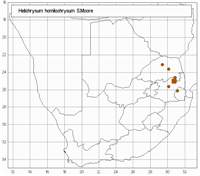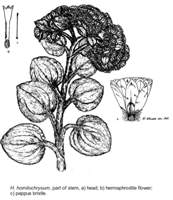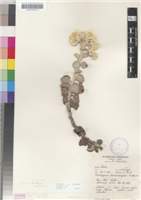Origin of name:
chrysum = yellow
Diagnostic characters:
Large heart-shaped leavesPlant covered in white woolLarge heads in compact branched inflorescenceLight yellow bracts
Description:
Shrubby, stems possibly up to 450 mm long, stout (8 mm diam. near base), woody, erect or decumbent, loosely branched, upper parts thickly white-woolly, closely leafy. Leaves 25�50 x 10�35 mm, sometimes smaller and distant below the heads, ovate or elliptic-ovate, abruptly contracted to a broad flat petiolar part roughly one thirtd the total leaf length, base auriculate, clasping, apex subacute to obtuse, mucronate, upper surface thinly woolly, lower thickly so. Heads homogamous, campanulate, c. 5 x 4 mm, double that across the radiating bracts, many in compact clusters corymbosely arranged at the branch tips. Involucral bracts in c. 5. series, subequal, slightly exceeding flowers, very loosely imbricate, outer acute, inner obtuse, slightly crisped, semi-opaque, glossy, pale straw-yellow. Receptacle with fimbrils about equaling ovaries. Flowers 14�26, yellow. Achenes 1 mm long, cylindric, with myxogenic duplex hairs. Pappus bristles shorter than corolla, scabrid, bases cohering lightly by patent cilia.
Flowering between July and September.
Distribution:
Grows on cliff faces and edges. Endemic to the Mpumalanga highlands, and recorded from Mariepskop, Magalieskop, Mac Mac near Sabie, and Mount Anderson, at c. 1 500 m.
Grassland and Savanna Biomes.
Taxonomy:
Literature:
Helichrysum homilochrysum S. Moore in J. Bot., Lond. 37: 371 (1899); Moeser in Bot. Jb. 44: 313 (1910).
Type:
Mpumalanga, Lydenburg distr., Devil's Knuckles, Aug. 1884, Wilms 716 (BM, holo.; K, iso.).
Synonym(s):
Vouchers:
MacLea 3013 (BOL; K; SAM); Rogers in TM 20306 (PRE), prob. = Rogers 22998 (Z).

